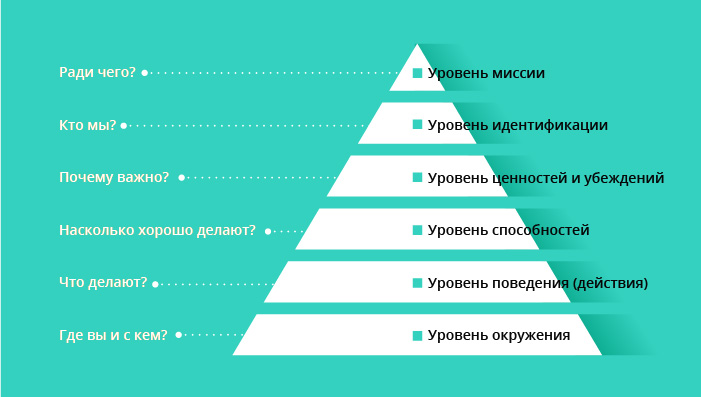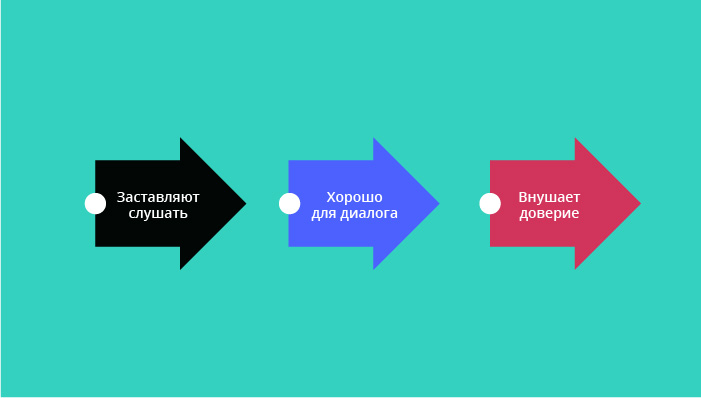Speech pyramid: how to generate trust of the audience with the help of Dilts levels
A decision on a project or funding a startup may depend on just one presentation. This is especially catching when you have to speak a professional who could have spent this time on development. If your company does not have individual managers who are engaged in marketing and sales, you can just in an hour master the pyramid of the speech, the method of non-directive impact on the audience and the rules for developing business presentations. Read more in this article.

When you develop a presentation for a report to a conference or other event, remember that the audience is usually not motivated to agree with your every word. This is normal - everyone has their own experience and beliefs. Before you say “Do it ...”, the author of the SpeechBook book, Alexey Andrianov, recommends preparing an audience. For this, he gives a pyramid match. Experienced managers can find out in it the pyramid of logic levels of Robert Dilts.

')
To set up an audience, just a couple of phrases about what surrounds the audience. Phrases should be obvious and understandable to all present. For example: “Colleagues, today is the middle of the month, we are going to discuss the results” or “Friends, today we will sort out the company's case together in this audience ...”.
Briefly tell about the actions of the audience. Action formulated in the verbs in the present tense: “do”, “decide”, “change”. For example: "Every day we meet with customers" or "Market situation changes every minute."
Suggestions at this level reflect your assessment of the actions being voiced. Speak with adjectives: “fast”, “better here — worse there”, “lower”, etc. Examples: “The results of the divisions are different, here’s the rating” or “This product entered the market in 3 months, but this time the launch stretched for a year. "
Transitional from levels of lower order to entities. One short sentence is enough to indicate value. Marker words: “Believe”, “Important”, “Main”, “Valuable”, “Love”. For example, “There is nothing more important than the independence of the company” or “I believe that this approach will help defeat the competition”.
The shortest in speech. Which group do you belong to? “We are HRy”, “We are sellers”, “We are investors”, “We are marketers”. Remember for whom you have created a presentation for the conference or evaluate who is in front of you. Perhaps there will be an even more powerful identification "We are experts in the sale of unique equipment."
It is here that we need to talk about why everything is being done. Remind the audience of this and activate it to action. “It depends on us today what the company will be tomorrow”, “For the sake of launching a new technology for treating children”, “For our relatives to live in prosperity” - here are some examples.
Only after you have raised your audience at all levels can you be called to action. What do you want the audience to do? Raise your voice a little and say it. Start with a verb in the imperative.
What other non-directive impact? There are numbers, data, graphics! Of course, but they are enough only for one part of the hemisphere, and the person makes a decision also on an emotional level. To activate, you need to turn to the representative system of the listener, to enable the audience to present your information in their head. The story best copes with this, because it helps the listener to find examples from her experience and to combine them with the data during the presentation.
Remember the famous performance of Steve Jobs to Stanford University graduates? He told three stories from his life, substantiating his position and his call to action for the audience. Using only the language of business, this effect is impossible to achieve. We make decisions by the brain, but let them through emotions. History quickly raises the listener to the level of personal values.
To prepare a presentation for a public appearance with a story, the author suggests using the structure:
The logic of a business presentation depends on its purpose, subject matter, target audience and context. The author proposes two schemes that in general will work. These are the sequences “Past-present-future” and “Problem-proposal-plan”.

The structure of the scheme "Past - present - future"

The structure of the scheme "Problem-proposal-plan"
Write in the comments that you would be interested to read about creating presentations.

Pyramid Speech
When you develop a presentation for a report to a conference or other event, remember that the audience is usually not motivated to agree with your every word. This is normal - everyone has their own experience and beliefs. Before you say “Do it ...”, the author of the SpeechBook book, Alexey Andrianov, recommends preparing an audience. For this, he gives a pyramid match. Experienced managers can find out in it the pyramid of logic levels of Robert Dilts.

')
1. The level of the environment
To set up an audience, just a couple of phrases about what surrounds the audience. Phrases should be obvious and understandable to all present. For example: “Colleagues, today is the middle of the month, we are going to discuss the results” or “Friends, today we will sort out the company's case together in this audience ...”.
2. The level of behavior
Briefly tell about the actions of the audience. Action formulated in the verbs in the present tense: “do”, “decide”, “change”. For example: "Every day we meet with customers" or "Market situation changes every minute."
3. Ability level
Suggestions at this level reflect your assessment of the actions being voiced. Speak with adjectives: “fast”, “better here — worse there”, “lower”, etc. Examples: “The results of the divisions are different, here’s the rating” or “This product entered the market in 3 months, but this time the launch stretched for a year. "
four. Level of values and beliefs
Transitional from levels of lower order to entities. One short sentence is enough to indicate value. Marker words: “Believe”, “Important”, “Main”, “Valuable”, “Love”. For example, “There is nothing more important than the independence of the company” or “I believe that this approach will help defeat the competition”.
five. Identification level
The shortest in speech. Which group do you belong to? “We are HRy”, “We are sellers”, “We are investors”, “We are marketers”. Remember for whom you have created a presentation for the conference or evaluate who is in front of you. Perhaps there will be an even more powerful identification "We are experts in the sale of unique equipment."
6. Mission Level
It is here that we need to talk about why everything is being done. Remind the audience of this and activate it to action. “It depends on us today what the company will be tomorrow”, “For the sake of launching a new technology for treating children”, “For our relatives to live in prosperity” - here are some examples.
7. Downhill
Only after you have raised your audience at all levels can you be called to action. What do you want the audience to do? Raise your voice a little and say it. Start with a verb in the imperative.
Non-directive impact
What other non-directive impact? There are numbers, data, graphics! Of course, but they are enough only for one part of the hemisphere, and the person makes a decision also on an emotional level. To activate, you need to turn to the representative system of the listener, to enable the audience to present your information in their head. The story best copes with this, because it helps the listener to find examples from her experience and to combine them with the data during the presentation.
Remember the famous performance of Steve Jobs to Stanford University graduates? He told three stories from his life, substantiating his position and his call to action for the audience. Using only the language of business, this effect is impossible to achieve. We make decisions by the brain, but let them through emotions. History quickly raises the listener to the level of personal values.
To prepare a presentation for a public appearance with a story, the author suggests using the structure:
- Introduction
- Character
- Outbreak (problem, crisis, obstacle)
- Voltage buildup
- Climax
- Decoupling
Business presentation logic
The logic of a business presentation depends on its purpose, subject matter, target audience and context. The author proposes two schemes that in general will work. These are the sequences “Past-present-future” and “Problem-proposal-plan”.

The structure of the scheme "Past - present - future"

The structure of the scheme "Problem-proposal-plan"
Write in the comments that you would be interested to read about creating presentations.
Source: https://habr.com/ru/post/456532/
All Articles